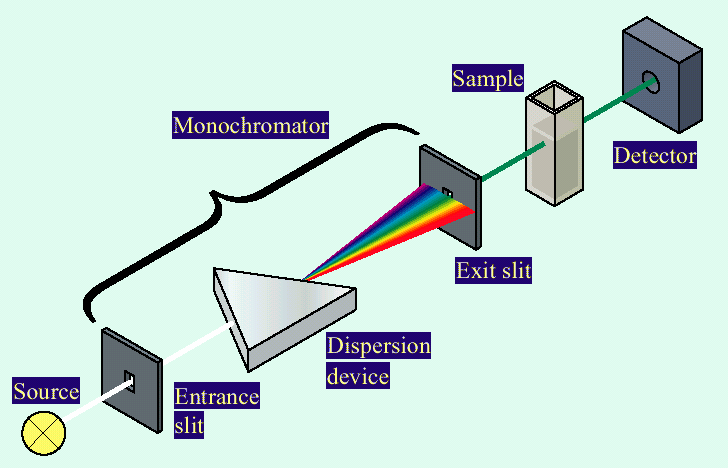Table of Contents
Introduction to UV-VIS Spectrometer
In laboratory analysis, UV-VIS spectrometers provide the ability to analyze the range of ultraviolet and visible light absorbance and transmittance. Environmental scientists and chemists depend on the precision of UV-VIS spectrometers. Understanding the functionality of the device can enhance a researcher’s analysis, whether in basic property studies or complex mixture analysis.
How Does a UV-VIS Spectrometer Work?

The transmitted wavelengths are employed in quantifying the concentrations of various analytes present in the sample. The spectrometer displays a spectrum of absorbed/transmitted light showing intensity versus wavelength and identifies the different analytes in the sample.
By accessing the stored and retrieved data, the various analytes and concentrations of each substance are calculated in the sample. The precision in UV-VIS spectroscopy thus accounts for its value in diverse verticals such as chemistry, biology, and environmental science.
Advantages of UV-VIS Spectrometer
UV-VIS spectrometers are a favorite in many labs, and there are good reasons for that. For many scientists, the ability of a spectrometer to deliver fast results and to deliver results accurately cannot be overstated. UV-VIS spectrometers are characteristically multifunctional. They are used in environmental testing and for analysis in many branches of the pharma sector, and many others, and that is why they are considered versatile.
In addition to being multifunctional, UV-VIS spectrometers are also considered sensitive. They are able to analyze and quantify minute trace levels of a substance. Consequently, there is valuable insight in data that can be overlooked in less sensitive instruments. From a lab workflow perspective, are user-friendly and require minimal supervision. This is primarily because there is minimal training, and data can be rapidly analyzed. This is what makes it so valuable in the branch of analytical chemistry.
Applications of UV-VIS Spectrometer
There are a number of different applications for UV-VIS spectrometers. In the usage within the pharmaceutical industry, it is used in drug formulation and quality control. Analysts ensure the formulation of the active ingredients, and regulator standard compliance is achieved within the quality control process.
The monitoring of the environment is another application of UV-VIS spectroscopy. As pollutants are measured, the science of water pollutants and air quality is evaluated.
The UV-VIS spectroscopy in the food and beverage industry is used for evaluating the color and determining the nutritional value of the food and beverage products in order to ensure and evaluate the safety and quality. The educational analytical methods within scientific research also use UV-VIS spectrometers to illustrate principles.
Tips for Choosing the Right UV-VIS Spectrometer
Identify your analytical needs within various applications. Depending on application needs, different ranges and different resolutions are used. Consider the device’s sensitivity. Higher sensitivity is important to detect samples at low concentrations. Assess the device’s usability. Interfaces save time and minimize analysis errors.
Support software integration. Ensure software compatibility with analytical programs.
Yes, consider your budget. Prices vary with brand reputation and features, so keep your budget aligned with your needs. Consider the customer support provided by a manufacturer/supplier. Quality support saves time when problems arise and you have questions.
Care and Maintenance of UV-VIS Spectrometer
Proper care and maintenance of your UV VIS spectrometer will increase its longevity and improve its functional capabilities. Cleaning of the UV VIS spectrometer is also a most crucial step. Make sure to eliminate any dust and fingerprints that have accumulated on the optical surfaces that may affect readings and may be distorted. You can use a lint-free cloth and an appropriate cleaning solution to rectify this problem. For data integrity, calibrating your unit is important. Even though the manufacturer guidelines provide a means to perform care and maintenance, it is also wise to determine your personal spectrometer best practices to maintain data integrity. You provide the most reliable and consistent results, and you must be proud of that.
Please ensure that the spectrometer connections are checked and assured to be properly connected and secured routinely to avoid any malfunction. Defective spectrometer cables or loose connectors can result in reading gaps, which in turn can cause a malfunction in the spectrometer.
Lastly, extreme climate conditions, such as excessive humidity or heat, and extreme cold, should also be avoided. A dedicated cabinet will also help in preventing inadvertent physical damage and will be stored when not in use. Due to clients ’ machines being the first in the instrument, it’s best to ensure that the machine has regular preventative maintenance in a schedule based on clients’ UV-VIS use in order to analyze climate-controlled/stored data for clients, which will ensure integrity.
Conclusion
The UV-VIS spectrometer is an important instrument for different sectors. This spectrometer is useful across various branches, including research and development, environmental monitoring, quality control, and materials and compound evaluation. Continuous development enhances different technological aspects of instruments, making the time spent in selecting the right option more worthwhile.
The UV-VIS spectrometer expands one’s understanding of the field, whether a beginner or an expert in analytical chemistry and other relevant fields. This understanding is beneficial for experimentation and innovativeness in the field. The trust placed in the analytical results is invaluable in myriad fields, making the spectrometer important for the accuracy of the analysis.
